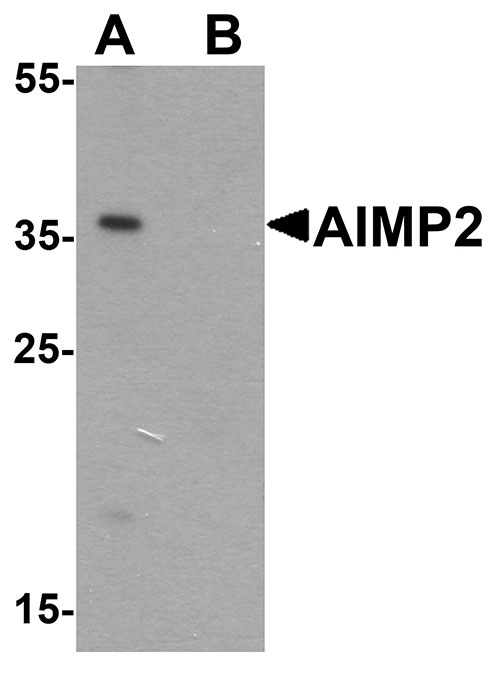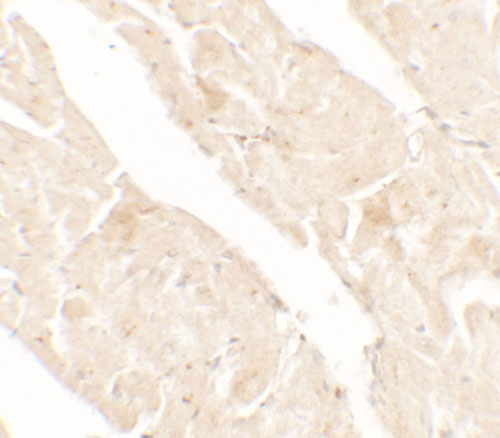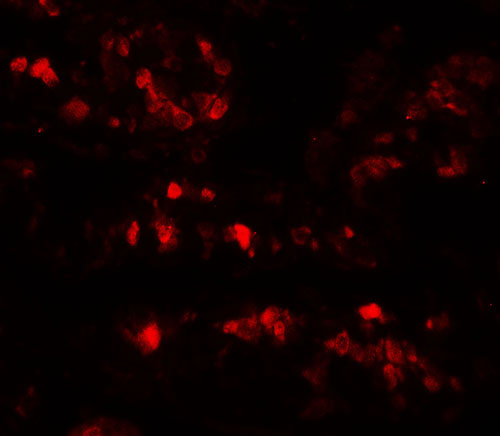AIMP2 Antibody
- 产品详情
- 实验流程
- 背景知识
Application
| WB, IF, E, IHC-P |
|---|---|
| Primary Accession | Q13155 |
| Other Accession | NP_006294, 11125770 |
| Reactivity | Human |
| Host | Rabbit |
| Clonality | Polyclonal |
| Isotype | IgG |
| Calculated MW | 35349 Da |
| Concentration (mg/ml) | 1 mg/mL |
| Conjugate | Unconjugated |
| Application Notes | AIMP2 antibody can be used for detection of AIMP2 by Western blot at 1 - 2 µg/ml. |
| Gene ID | 7965 |
|---|---|
| Other Names | Aminoacyl tRNA synthase complex-interacting multifunctional protein 2, Multisynthase complex auxiliary component p38, Protein JTV-1, AIMP2, JTV1 |
| Target/Specificity | AIMP2; AIMP2 antibody is human specific. AIMP2 antibody is predicted to not cross-react with AIMP1. |
| Reconstitution & Storage | AIMP2 antibody can be stored at 4℃ for three months and -20℃, stable for up to one year. |
| Precautions | AIMP2 Antibody is for research use only and not for use in diagnostic or therapeutic procedures. |
| Name | AIMP2 |
|---|---|
| Synonyms | JTV1 |
| Function | Required for assembly and stability of the aminoacyl-tRNA synthase complex (PubMed:19131329). Mediates ubiquitination and degradation of FUBP1, a transcriptional activator of MYC, leading to MYC down-regulation which is required for aveolar type II cell differentiation. Blocks MDM2-mediated ubiquitination and degradation of p53/TP53. Functions as a proapoptotic factor. |
| Cellular Location | Cytoplasm, cytosol. Nucleus {ECO:0000250|UniProtKB:Q8R010}. Note=Following DNA damage, dissociates from the aminoacyl-tRNA synthase complex and translocates from the cytoplasm to the nucleus. {ECO:0000250|UniProtKB:Q8R010} |
For Research Use Only. Not For Use In Diagnostic Procedures.
Provided below are standard protocols that you may find useful for product applications.
BACKGROUND
AIMP2 was initially identified as a part of an aminoacyl-tRNA synthesase complex (1). It was later discovered to be a cofactor and substrate of Parkin, a Ring-type E3 ubiquitin ligase that is important for the survival of dopamine neurons in Parkinson’s disease; accumulation of AIMP2 in these cells lead to catecholaminergic cell death (2). AIMP2 can also bind to TRAF2, a key player in the TNF-alpha signaling pathway, causing the ubiquitination of TRAF2 by cIAP1, leading to TNF-alpha-dependent apoptosis (3). Finally, AIMP2 has been suggested to function as a tumor suppressor (4).
REFERENCES
Quevillon S, Robinson JC, Berthonneau E, et al. Macromolecular assemblage of aminoacyl-tRNA synthetases: identification of protein-protein interactions and characterization of a core protein. J. Mol. Biol. 1999; 285:183-95.
Ko HS, von Coelln R, Sriram SR, et al. Accumulation of the authentic parkin substrate aminoacyl-tRNA synthetase cofactor, p38/JTV-1, leads to catecholaminergic cell death. J. Neruosci. 2005; 25:7968-78.
Choi JW, Kim DG, Park MC, et al. AIMP2 promotes TNFalpha-dependent apoptosis via ubiquitin-mediated degradation of TRAF2. J. Cell Sci. 2009; 122:2710-5.
Choi JW, UM JY, Kundu JK, et al. Multidirectional tumor-suppressive activity of AIMP2/p38 and the enhanced susceptibility of AIMP2 heterozygous mice to carcinogenesis. Carcinogenesis 2009; 30:1638-44.
终于等到您。ABCEPTA(百远生物)抗体产品。
点击下方“我要评价 ”按钮提交您的反馈信息,您的反馈和评价是我们最宝贵的财富之一,
我们将在1-3个工作日内处理您的反馈信息。
如有疑问,联系:0512-88856768 tech-china@abcepta.com.























 癌症的基本特征包括细胞增殖、血管生成、迁移、凋亡逃避机制和细胞永生等。找到癌症发生过程中这些通路的关键标记物和对应的抗体用于检测至关重要。
癌症的基本特征包括细胞增殖、血管生成、迁移、凋亡逃避机制和细胞永生等。找到癌症发生过程中这些通路的关键标记物和对应的抗体用于检测至关重要。 为您推荐一个泛素化位点预测神器——泛素化分析工具,可以为您的蛋白的泛素化位点作出预测和评分。
为您推荐一个泛素化位点预测神器——泛素化分析工具,可以为您的蛋白的泛素化位点作出预测和评分。 细胞自噬受体图形绘图工具为你的蛋白的细胞受体结合位点作出预测和评分,识别结合到自噬通路中的蛋白是非常重要的,便于让我们理解自噬在正常生理、病理过程中的作用,如发育、细胞分化、神经退化性疾病、压力条件下、感染和癌症。
细胞自噬受体图形绘图工具为你的蛋白的细胞受体结合位点作出预测和评分,识别结合到自噬通路中的蛋白是非常重要的,便于让我们理解自噬在正常生理、病理过程中的作用,如发育、细胞分化、神经退化性疾病、压力条件下、感染和癌症。








